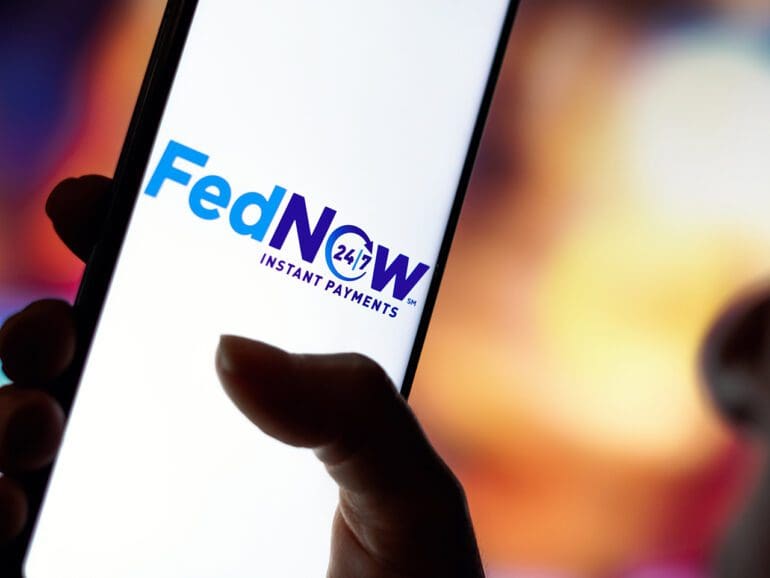Government-backed initiatives for real-time payments in the U.S. have lagged behind the rest of the world. However, the long-awaited FedNow is due to launch in a matter of weeks.
While the launch is merely the first step towards a fully launched federally developed real-time payments system, it is long overdue. The private sector has carried real-time payments until now, as the U.S. financial system has watched other jurisdictions, one by one, adopt country-wide instant payment networks.
As one of the most ambitious initiatives the Fed has taken in decades, it was sure to create a significant talking point, regardless of recent instability in banking. Some now see FedNow as a springboard for innovation, but for others, it is a railroad to instability, creating higher risks of bank runs and fraud.
How will the directive fit in for an industry still reeling from massive bank failures in March?
FedNow and the need for real-time payments in the U.S.
In a nutshell, FedNow is the real-time payment system the Federal Reserve has been developing for some years (it is not — as many on Twitter claim — a CBDC).
Participants can send and receive transactions between accounts in seconds, aimed at creating increased efficiency and cost. The service will be available 24 hours, 365 days a year, leaping forward from the banking system’s traditional limitations.

“If instant payments can be compared to the railroad system of the 1800s, FedNow is a new rail company helping connect companies and consumers from station to station that’s faster, more secure, and affordable than their horse and buggy predecessors,” said Rob Nardelli, Director of Commercial Banking at DailyPay.
The system will spread between banks and payment institutions, offering an alternative payment rail and instant access to received funds, which the Fed has said will “allow for greater financial flexibility when making time-sensitive payments.”
The Pilot program for the payment rail was launched in 2021, including more than 110 financial institutions. Participants spanned the banking and fintech ecosystems, allowing the sector to gauge the way forward.
Of course, it is not the first of its kind in the U.S. The Clearing House, a banking association owned by some of the largest banks in the country, launched its Real-Time Payments (RTP) system in 2017. Responding to a need for faster payments, the infrastructure has allowed any federally insured depository institution to offer real-time banking services to their customers.
Fintechs like Zelle and Venmo have created additional solutions. Initially, traditional networks such as the Automated Clearing House (ACH) enabled instant access to funds despite a delayed gross settlement. They have since moved to the RTP network.
Despite the current existence of such real-time options, the launch of FedNow has many in the industry excited. It is said to provide the service at a significantly reduced price to RTP and carry an additional level of perceived security as a network developed by the Federal Reserve, FedNow could spark a wave of innovation.
However, many turn to the example of RTP with concerns about FedNow adoption, despite the global trend supporting a need for widespread real-time payments.
What we’re seeing is more and more customers demanding real-time payments around the clock. They’re demanding safety and security. They’re demanding a more efficient way of doing payments.
– Kevin Greene, CEO of TassatPay
U.S. is lagging on real-time payments
It’s essential to add the infrastructure brought by FedNow, and The Clearing House’s RTP is not a new concept.
Real-time payments have existed for a while and have experienced prolific growth worldwide for over a decade. Predicted to have a market value of close to $200 billion by 2030, adoption has been swift and instant payments have become a part of the daily life of many.

“I don’t think you can go to any conference that’s payments related that doesn’t talk about faster payments. It’s all over the place,” said Al Carpetto, Head of Payments Strategy at Finastra, one of the institutions that took part in the FedNow pilot program. “If you follow the faster payments landscape, you realize that the United States is one of the last countries to be going on a faster payments scheme.”
One-by-one, governments around the world have implemented real-time payment systems with varying success. However, studies predict that with increased usage of mobile wallets and ongoing development of use cases, transaction volumes could reach 511.7 billion by 2027, making up over 27% of all electronic payments.
India, one of the initial adopters of instant payments, released their Immediate Payment Service in November 2010. This was then upgraded in 2016 with the Universal Payments Interface (UPI), which brought the capacity for payments to be made with QR codes, mobile numbers, and virtual IDs. The introduction of UPI sparked a wave of innovation, allowing wider access to the financial system through mobile wallets. Adoption was rapid, making them global leaders in the market. Real-time payments now make up 83.3% of all electronic payments.
More recently, Brazil launched the PIX infrastructure in 2020, allowing access to real-time payments year-round, at any time. This was built on the earlier infrastructure implemented in 2002, which only permitted transfers during banking hours. The launch of PIX brought unprecedented growth, and in the space of one year (2021-2022), transaction volumes were seen to increase by 228.9%.
Beyond the two poster children of technology, nations worldwide have been touched by the instant payments bug. Each continent is expected to have an average growth in market size of around 20%.
“It’s a system long overdue for us in the U.S. I think it’s great that we’re finally launching it as a government-backed initiative,” said Carpetto. The Fed owns it. It’s not a private initiative. And I think it will change the landscape very positively.”
The introduction of FedNow represents a significant step in modernizing payment systems in the U.S., offering businesses 24/7 payments at lower prices than is currently provided by the RTP system, amongst other options at a lower price.
Robert Quartly-Janeiro, Chief Strategy Officer, Bitrue.
Many have concerns about adoption

Since the launch of The Clearing House’s RTP in 2017, only a small percentage (around 3.2%) of banks have supported it.
“It’s going to be interesting to see how banks will adapt to the demand and availability of FedNow for small businesses,” said Nick Chandi, CEO and co-founder of ForwardAI.
While many of these banks are the largest in the country, resulting in a 65% coverage of all U.S. demand deposit accounts, this is a small feat in an ecosystem of over 10,000 banks and credit unions.
“Many of the larger banks are way in front of this and want to be a leader,” said Carpetto. He explained that the U.S. is home to one of the most complex financial systems globally. Navigating this complexity had already delayed the development of the infrastructure.
In the wake of the bank crisis, smaller banks have already been seen to suffer. Deposit outflows have increased steadily over the latter half of 2022, and with the collapse of three regional banks in the space of a month, many consumers turned to the “too-big-to-fail” banks in search of security. In April 2023, one month after the fall of SVB and Signature Bank, it was reported that JP Morgan’s deposits had grown by $50 billion following the crisis.
In early May, as First Republic and Western Pacific Bank showed distress, murmurs were heard stating that the “regional banking crisis” was far from over, and competition within the banking ecosystem was taking a hit. This, too, could be affected by FedNow.
Banks will need to make additional investments to incorporate the new payment rail. While, in large banks, technology budgets may be plentiful, it is likely to differ in smaller banks, possibly affecting their ability to compete.
Carpetto said that a lack of resources in the smaller banks could mean many delay their integration of the new payment rail. Small tech budgets and limited human resources may adapt their infrastructure at a cost initially deemed unnecessary.
In addition, unlike PIX, which had mandated adoption for banks, The Federal Reserve is unlikely to make the payment rail compulsory. This may mean adoption could be slow.
“When you look at this landscape of 10,000 banks, many are very small,” he said. “They have an interest but may not be ready yet.”
However, he also felt that adoption was inevitable.
“Everybody will eventually want it to have real-time payment access,” he said. “What I tell people is it’s really not a choice. If you’re a bank, you will eventually have to be on the Faster Payments route. You’ll have to be if you want to compete. I think their consumers will eventually pressure them to say, why don’t you have this? If you don’t have it, I will go to the other bank that does.”
“I just think people need to truly recognize that some work needs to be done on their side to prepare for it. And to make sure they’re using it appropriately.”
Perhaps a testament to customer demand for instant payments is adopting payment methods like Zelle and Venmo, already well-established among U.S. consumers.
Since launching in 2017, Zelle has been integrated into the mobile apps of more than 1,800 financial institutions. Working primarily to facilitate peer-to-peer transactions, the company’s focus allows consumers an almost instant payment experience. In 2022, the company said it handled 2.3 billion transactions worth $629 billion, a 26% increase year-over-year.
Some worry about faster bank runs
Although the industry is primarily optimistic about FedNow’s launch, new fears (and conspiracy theories) have arisen in light of the recent bank crisis.
The collapse of SVB and several other banks involved a series of bank runs at a much more accelerated pace than ever has been seen before. Many have blamed social media and heightened connectivity for facilitating the ease of communication and money movement.
Since March, as the launch date for FedNow looms, some have foretold the risks of a national real-time payment network on the banking system.
They state that the speed and ease of transfers will make a bank run far more difficult to stop, saying that March’s crisis could have been far worse if transfers were available around the clock.
However, others remain unconvinced of this risk, stating that given real-time systems have been introduced around the world, and even within the U.S., without issue.
“Real-time payment systems exist already, and you don’t see runs on banks,” said Carpetto. “I don’t think it’ll facilitate more or faster runs on the bank.”
Real-time fraud
The U.S.’s delay in government implementation of real-time payment has advantages, allowing the industry to use other models to gauge what’s to come. As such, fraud has also become a focus of heightened concern.
Related:
Instances of fraud within real-time payments have been steadily increasing. As money is transferred instantly, payment providers have had difficulties retrieving or stopping fraudulent transactions.
While identity theft and card detail theft are globally on the decline, fraud related to real-time payments is on the rise. In India, currently the global leader in real-time payments, instances of fraud in 2022 in by 44.6%. Brazil, too, has seen rising levels related to national usage of PIX.

“It’s so easy to send money, and the transactions are irrevocable,” said Alexandre Pinto, VP of Product, Banking at Pismo. “If you send money, it’s gone. Unlike a credit card, you can call your future bank and say that you dispute that purchase and get the chargeback. Usually, that doesn’t happen.”
He explained that in Brazil, this has led to instances where people had been scammed via Whatsapp by people claiming to be family members in distress. Fraudsters have used the emotional reaction of targets to swindle vast sums that could not be retrieved due to the nature of real-time payments.
To this, many believe steps toward increased fraud detection will be critical, allowing for providers to react to fraud at a speed that matches real-time payment.
FedNow will provide a springboard for innovation
FedNow Youtube video
Sparking a wave of Innovation
Fraud aside, many in the ecosystem see the introduction of FedNow as an opportunity for increased innovation in the U.S. financial services system.
Although startups have already been built to fulfill the demand for instant payments, there is a general consensus that the introduction of FedNow could enhance existing solutions and create a need for additional products.

“FedNow is an important step forward in enabling a better payments experience within the U.S.,” Devon Kirk, Partner & Co-Head, Portage Capital Solutions. “I’d like to see the program expanded to include fintechs to facilitate more widespread adoption and support competition and innovation across financial services.”
“There is a growing need for fraud and compliance tools in this environment. FedNow is a good example where the payments innovation will drive demand for other tools, especially to enable larger transaction size limits.”
Fintech, in particular, could be an essential part of FedNow’s integration into the broader ecosystem. Increased innovation in the sector as the infrastructure rolls out could develop current usage of real-time payments infrastructure and create new use cases to drive adoption.
“Only a fraction of financial institutions using the real-time payment to date have made the Push side of the real-time payments available to their clients,” said Chandi. “Most banks have been interested in ‘Receive Only’ to accept payments delivered on the real-time payments rail. The problem is within the traditional bank’s business model, which entails holding onto funds and processing payments for as long as possible.”
“There’s much to be said about fintech filling the gap between small businesses and banks. This is where fintechs are best positioned to solve the gap: creating a bank-agnostic instant experience. We’ve seen real-time payment adoption in places like the UK, Brazil, and India skyrocket in only a few years. I suspect we’ll see the same as fintechs offer improved payment options.”
The relationship could be mutually beneficial. For example, TassatPay, an instant payments infrastructure provider for banks and financial institutions, has, until now, only been able to operate fiat transactions during traditional banking hours despite having the infrastructure to enable instant settlement.

“The TassatPay network on the blockchain can operate around the clock. And we can net transactions amongst banks around the clock. But we can only move fiat currency when the Fed window opens from nine to five. With FedNow, we will then be able to both net and settle around the clock. That’s a big plus,” said Kevin Greene, CEO of Tassat Pay.
While its launch is likely to benefit TassatPay, he explained that it, and similar solutions, could fit in as a ramp for institutions to take advantage of the infrastructure. “It’s just a communications protocol. Ultimately, the banks have to figure out how to integrate to the core banking system had delivered to their customers in innovative ways,” said Greene.
There is an air of excitement and expectancy surrounding the FedNow launch, with many considering it the start of a new era in the U.S. financial service industry.
“As a provider of services, we’re excited because it creates opportunities for us to create new and better products for them to use,” said Carpetto. “As a consumer, it excites me because it’ll drive tons of new use cases.”
“In the United States, there are already discussions with some banks on how they’re going to use real-time payments to drive better liquidity models so that you could move money on a real-time basis to take advantage of liquidity products in the market.”
“There are other use cases already being discussed about real estate transactions. When you go to a closing today, you need to bring certified checks and do this other fancy stuff that you have to go to a bank and get these checks physically. You don’t have to do that anymore. You can go to real-time payments and pay for it. You know, you want to buy a car on the weekend, you can have a real-time payment sent to cover the down payment or the payment for the car.”
“I believe there will be tons of use cases that will drive that competitive landscape.”
In a world where most things can be obtained on demand at an ever-increasing pace, it’s about time the U.S. banking system can do the same.
FedNow entering into the instant payments arena gives yet another option to fintechs and banks, that is faster, more secure and affordable.
We welcome having another option for these faster and more secure payments that allows us to make EWA payments at a lower cost. It’s going to have a profound effect on how we can offer our solution to the employees we serve, if and when they should need access to their wages.
Rob Nardelli, Director of Commercial Banking at DailyPay.


